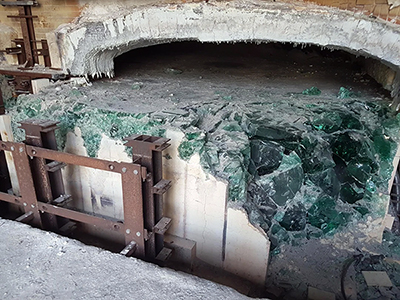
Why does the end fired glass furnace has the bottom leakage during the melting process?
I. General introduction on melting tank bottom
Due to various reasons, sometimes a material leakage accident occurs in a furnace after one or two years of operation, and the furnace is forced to shut down. In serious cases, it may cause serious accidents involving casualties. Leakage at the bottom of the melting tank is often the main form of short-term leakage. The reason is that leakage at the bottom of the tank bottom cannot be observed in time and cannot be repaired.

II. The main factors causing material leakage at the bottom of the glass furnace
1. With the increase of unit melting rate, the insulation of the bottom of the pool is getting better and better, and the fluidity of glass is enhanced.
In order to meet the requirements of energy saving, the insulation of the bottom of the melting tank is getting better and better. Good thermal insulation not only helps reduce heat loss, but also increases the specific melting rate. Coupled with more and more electric boosting at the bottom of the tank, the temperature at the bottom of the tank will be greatly increased. In this way, the fluidity of the glass is enhanced and it easily penetrates into the mud layer under the paving blocks.
2. metal in broken glass cullet
Nowadays, more and more cullet glass is used in making bottle glass. If the metallic impurities such as iron in the cullet are not completely eliminated, they will lead to undercutting. This is due to the fact that metal impurities with low melting points turn into molten metal and corrode in a manner similar to the upward erosion of molten glass on refractory materials. Once the molten metal or molten glass passes through the brick joints and contacts the ramming material underneath the paving bricks, it will erode upward.
.png)
The stalactite-like erosion phenomenon clearly shown in above picture is a typical upward drilling erosion phenomenon.
The light yellow ones are fused zirconium corundum bricks(AZS), and the green ones are glass. You can see that the glass liquid has completely penetrated under the paving tiles. Many glass factories mistakenly believe that corrosion is caused by poor quality of paving tiles. This just ignores the essence of the problem: the foaming of the ramming material is the real cause of upward undercutting.
III. SNR Glass bottle furnace bottom unshaped material solution
Many of SNR's glass kiln customers at home and abroad use mostly zirconium-containing ramming material series products developed by SNR. Mainly include, AZS50V, AZS06L, AZS04J, ZS60/65, etc. They are all made of electro-fused AZS particles through a special process.

The particle diameter of AZS50V is 5mm. It is mixed with water and hardens quickly. It is used to cast the base layer of the pool bottom. The thickness is about 45mm.
The maximum diameter of the particles of AZS06L is 0.6mm. When laid on top of AZS50V, the thickness is about 5mm.
.jpg)
The maximum diameter of the particles of AZS06L is 0.6mm. When laid on top of AZS50V, the thickness is about 5mm.
At high temperatures, the glass phase will precipitate. After the temperature continues to rise, the glass phase will crystallize, and the material will become ceramic and gradually fuse into one unit. In this way, the entire pool bottom material is combined into an airtight and indivisible whole, with no gaps for the glass liquid to continue to flow.
IV. It is recommended to use double-layer AZS50V ramming material for large, efficient and high transmittance furnaces.
As shown in the figure below, the pool bottom structure using double-layer AZS50V (such as 2x50mm) is:
First layer: AZS paving tiles(SNR AZS33#WS)
Second layer: AZS06L leveling layer
The third layer: the second layer of AZS50V castable
The fourth layer: the first layer of AZS50V castable
Fifth layer: sintered AZS bricks(SNR bonded AZS blocks)
.jpg)
The expansion coefficients of the first layer (4th layer) of SNR's AZS06L castable and the sintered AZS bricks (5th layer) are different, which may cause cracking during the kiln baking process. The second layer of AZS50V castable has the same composition as the upper and lower parts, that is, it expands the same. This can effectively protect the smooth movement of the second layer of AZS50V castable from cracking, prevent the penetration of glass liquid, and completely protect the bottom of the pool.
V. Conclusion
1. The main reason for material leakage at the bottom of the daily glass kiln (furnace) is that daily glass uses more recycled cullet than building material glass, and insufficient investment in sorting facilities cannot effectively remove metal objects in the cullet, which can easily lead to glass leakage and downward erosion of metal objects; once the glass comes into contact with the ramming material, the uneven characteristics and quality of the ramming material often lead to upward erosion. In this way, the paving tiles are heated up and down and eroded quickly. This also causes material leakage at the bottom of the pool in a short period of time.
2. Due to its product characteristics and pouring and vibration process, SNR ramming mix products have extremely low porosity, which can effectively prevent the leakage of molten glass.
3. The double-layer process (SNR AZS50V/06L) provides additional protection for the furnace with high melting rate and high transmittance.

SNR Refractories Bricks, we always focus on our quality refractory materials for furnace application home and abroad.
whatsapp:+86-18203976036, email: davis@snrefractory.com